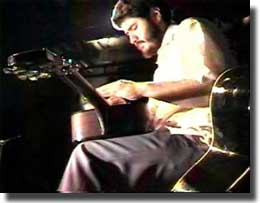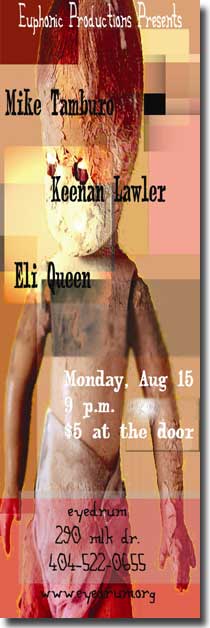|
Mon, 15 August 2005
 Euphonic Productions presents: Euphonic Productions presents:
Mike Tamburo
Keenan Lawler
Eli Queen
9pm, Mon, Aug. 15
$5 at the door
Eyedrum
290 MLK Jr. Drive, Suite 8
404-522-0655
www.eyedrum.org
(experimental)
Mike Tamburo has been a member of the Pittsburgh avant garde music scene as an integral part of crystalline drumless drone rock structures of Meisha and the more-free flowing ethnic apocalypse music of Arco Flute Foundation, as well as countless spontaneous performances and post-gathering improv sessions.
 Mike Tamburo has created a pristine document of new American ethnic guitar music channeling energies similar to the likes of Fahey, Windy & Carl, Six Organs of Admittance, Gastr del Sol, Charlemagne Palestine, Loren Connors, and Tower Recordings. Tamburo approaches guitar with the constant joy of discovering new sounds and techniques. Mike Tamburo has created a pristine document of new American ethnic guitar music channeling energies similar to the likes of Fahey, Windy & Carl, Six Organs of Admittance, Gastr del Sol, Charlemagne Palestine, Loren Connors, and Tower Recordings. Tamburo approaches guitar with the constant joy of discovering new sounds and techniques.
As one of the main players behind Meisha and Arco Flute Foundation, Tamburo has dedicated himself to exploring the nuances of his guitar in a group setting. With his first solo release, Tamburo combines guitar with sounds from a wide range of sources, including organ, keyboard, electronics, Tibetan bowl, alarm clock, accordion, piano, ebow, bowed guitar, mandolin, percussive guitar, electric piano, effects, and other engineering, to explore and hone in on a more singular sound and vision.
- The Music Fellowship
"The acoustic guitar isn’t a new instrument to Mike Tamburo. It was his main axe, as it were, in his former outfits, Meisha and Arco Flute Foundation, though Beating of the Rewound Son, Tamburo’s solo debut, leaves his playing rather starkly unadorned by sidemen or accompaniment. Tamburo’s no purist, he has no qualms with regard to augmenting his pieces with other instruments, or making use of nontraditional techniques in his playing, but his emergence as a solo artist marks a turn into more folk-tinged territory for the guitarist. Comparisons in his playing can be made to the usual suspects, Fahey, Basho-Junghans, and their ilk, but Tamburo isn’t a straight disciple of any of the prevalent deities of acoustic guitardom.
“Adam’s Fruit Temptation” not only begins the disc, but it’s the album’s highlight. Tamburo weaves expertly some of his best melodic work with subtle atmospherics and washes of delay. It’s a study in well-executed transitions, a mini-suite that, while it contains a good deal of Tamburo’s most traditional fare, easily deters boredom or monotony. The tracks that follow sometimes diverge from this path, with Tamburo’s more experimental penchants taking hold. “Kremlin Krab” loops and layers piano in a shimmering weave of swimming layers. Minimalism plays a part in Tamburo’s work as well, though drones aren’t a prominent feature of his work, his use of looping and electronics touches, at times, on a more active repetition. Tamburo proves more than once that he’s more than capable at folk forms and melodic constructions, so the inclusion of effects, electronics, keyboard, and other interlopers into his clean unaccompanied tone are surely not there to mask his playing or muddy the waters. The album’s largely successful avoidance of excess sentimentality is owed, in part, to these more varied stretches; they’re also a handy way to inject variety into the disc. Tamburo’s clever arrangement of even his most straightforward segments provides for stimulating listening, though Beating of the Rewound Son is never so heady it dispenses with its emotional heft.
In a musical climate that seems hungry for acoustic guitarists who aren’t afraid to veer from the beaten path (see continued reverence of Fahey, the emergence of Basho-Junghans into the American consciousness, and the exaltation with which Sir Richard Bishop’s last disc was received), Mike Tamburo, in Beating of the Rewound Son, has made an intelligent and impressive debut."
- Fake Jazz
www.miketamburo.com/
Keenan Lawler, born Glasgow, KY 1964, began his early musical life experimenting with flanging tapedecks and reverb tanks .In i981 he started an exploration of electric guitar and quickly established a distinct musicality and compositional sense. He began collaborating with a myriad of eclectic ensembles in the areas of Louisville & Lexington Kentucky playing everything from free improvisation to avant garde rock. A fascination with drone music of non western cultures brought him to Terry Riley and Tony Conrad, further solidifying the impression of sound & time .In 1990, he involved himself with composing and improvising music based on the technology of digital delay, looping and sampling. Around 1997, Lawler started to develop a vocabulary for the most unlikely of musical instruments, the resonator guitar. Drawn initially to the powerful depth and haunting ambience of the guitar while steadily incorporating sampling electronics & custom signal processors to create a unique voice. Once a quietly celebrated anomaly, Lawler has emerged as Kentucky's most prominent sound artist/experimental musician performing extensively and collaborating with such artists as Matmos, David First and Rhys Chatham. He has released his own work on the Konstant label.
"A Suspension In Dreamtime" (1998) is a composition concerned with transformative nature of sound. Non-electronic processes and techniques were employed to achieve a dense mass of overtones and metallic sustaining textures generated from an uneffected acoustic instrument. The four sections of this piece were created using only prepared and bowed metal bodied resonator guitar, microphones and piezo pickups recorded into a digital multi track recorder. Each track contained a specific isolated range of microtuned harmonics giving finer manipulation and control over the frequency spectra. These separate bands of sound were then combined into a cohesive sound picture with the cumulative effect of resonance creating a halo around the shifting polytonal center. This piece was inspired by an interest in minimalism, electronic trance music, electro-acoustic sound, audio entrainment and common often-chaotic cyclic events found in modern life.
"Keenan Lawler is the bleeding edge of the Lousiville, KY music scene these days.
That's what he told me shortly after I met the 35-year old experimental steel guitarist, just after his set at the Transmissions Festival in Chapel Hill. Lawler's performance utilized the warm acoustic tones of his instrument through digital manipualtions, sampled and multi-tracked to create a very dense environment.
The Ghost of a Plane of Air touches on many modern-day minimalist composers, while also drawing inspiration from the recent wave of abstract electronics, but is infused with Lawler's own original ideas. Describing his work as process-based composing, Lawler blurs the lines between improvisation and strict composition. Certainly chance factors into his music in some way, but much of the sound on this disc is clearly very deliberate.
Lawler's music is unique, touching on just intonation and power electronics at the same time. The final track, "A Suspension in Dream Time," stretches out a peacful atmosphere over 22 minutes. This aptly-named track is beautiful and easy to get lost in; by placing it at the end of the disc it provides a lush soundtrack to drift off to sleep with. Ghost of a Plane of Air is not all ambient bliss -- some tracks are quite harsh and electronic sounding, although all of the source material is derived from a steel guitar."
- Fake Jazz
www.konstant.com/av.htm
Stubbornly refusing to limit his minimal creations Eli Queen wrestles between gloomy despondent murmurs on guitar and shiny brilliant tones. It’s the soundtrack to every movie you’ve always wanted to see but was never made or written. Indeed the “Oxygen Mysteries” portion of the title allows you to envision the birth of plant life on a planet clogged with congestion and all too fast lives as if it was some science film produced by some unknown British documentary company that is frayed and barely survives its time on the film reel. Ingenious in a subtle way, this is the music that will truly stir your soul.
www.sleepingweather.com
Eyedrum’s programming is supported in part by the City of Atlanta Bureau of Cultural Affairs.
Home
|